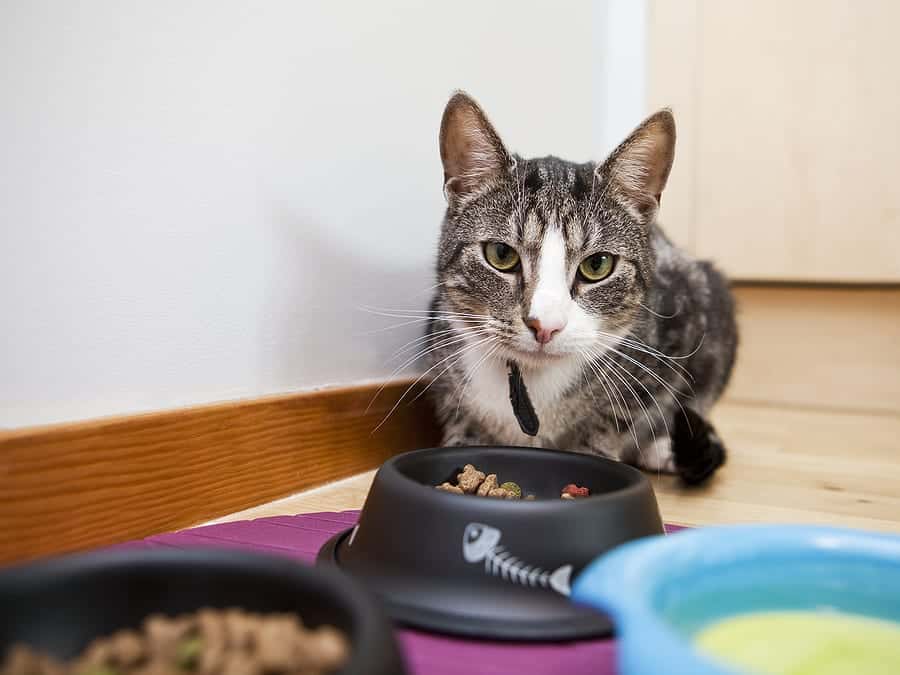In 2018, a study by the Association for Pet Obesity Prevention found that an unnerving 59.5% of cats are overweight or obese. If you narrow that population down to indoor-only cats, vets predict that number would be even more alarming. The problem with keeping an indoor cat at a healthy weight is that their cushy lifestyle can easily backfire health-wise. There’s less territory to explore, so indoor cats are more likely to nap than they are to move around or exercise. Low exercise coupled with poor diet practices leads to cats that are dangerously overweight.
The truth is, most overweight cats have their owners to blame. It’s up to the humans in the family to keep cats healthy. Thankfully, keeping an indoor cat at a healthy weight isn’t impossible. You might have to change a few things about your cat’s routine, but these tips will help your cat stay fit and trim.
1. Reevaluate Your Cat’s Food
It should be a no-brainer that not all cat food is the same. Different brands use different ingredients, and different formulas can either help or hurt your cat. If your cat is already overweight, they’d likely do best with a reduced calorie type of food. Wet food usually has fewer calories than dry food, and the moisture also helps cats feel full longer. But if your cat is currently at a healthy weight, and you’re reading this because you want to keep them that way, reduced calorie might not be the way to go.
Knowing what kind of food will be best for your cat is a job best left to your vet. They can evaluate your cat’s overall health and lifestyle and point you in the direction of a food that will provide all the necessary nutrition without overdoing it.
2. Don’t Free Feed
Free feeding is when you leave food in your cat’s bowl all day and allow them to eat whenever you want. This method can be easier for families with busy schedules, but it won’t keep an indoor cat at a healthy weight. Contrary to popular belief, you can’t expect your cat to regulate how much they eat. Just like humans, if food is available, there’s a good chance they’ll eat a lot more than the recommended serving size.
One of the keys to healthy eating is portion control. You can’t keep track of how much your cat actually eats when there’s constantly food in their bowl. A better strategy is to have designated meal times. Leave your cat’s food out for a set number of minutes and then take it away. They’ll eventually learn the time limit, and you can better control their diet.
3. Make Life More Interesting
Life for an indoor cat is cushy and cozy, but it can also be boring. Their territory is limited to how big your house is, and once they know their way around, there’s not a lot to explore. It’s easy for indoor cats to slip into a daily routine full of naps and boredom.
Just like humans, cats tend to eat more when they’re bored. Too many treats combined with little exercise is a recipe for weight gain. You can avoid this problem by making life more interesting for your cat. Add things like cat trees and maybe even a feline-friendly garden to his environment. Make sure they have a variety of toys, scratchers, and a spot by the window where they can watch birds and squirrels.
4. Play!
While you’re thinking of ways to make your cat’s life more interesting, don’t forget about play time. Playing with your cat for at least 15 minutes twice a day has so many benefits. It will improve both their mood and your bond, and playing is also great exercise to keep indoor cats at a healthy weight.
Different cats have different play styles, so try out different games to find what you and your cat like. All that matters is that your cat is active and engaged. They’ll burn calories while having fun, and that can eventually lead to weight loss.
5. Make Sure They’re Drinking
Drinking water can make a cat feel fuller and less likely to beg for treats. The water fills in those hunger cracks, and if your cat takes a drink, they might forget they were feeling hungry in the first place. The problem is, most cats don’t drink as much as they should.
Cats aren’t big drinkers, and most of them walk around at least slightly dehydrated. You can help fight this by always making sure your cat has easy access to fresh, clean water. If you have a larger house, have multiple water dishes so your cat never has to travel far for a drink. You can also try water fountains and bubblers to make drinking more appealing to your stubborn cat.
Above all else, the best way to keep an indoor cat at a healthy weight is to stay in communication with your vet. It can be hard to notice when your cat slowly starts putting on the pounds. You might not realize there’s a problem, but a trip to the vet and a step on the scale will always tell you the truth. Helping an indoor cat stay at a healthy weight will take consistency, but once you get in the routine, it’s easy to do.






